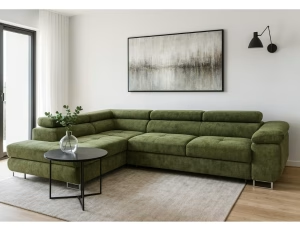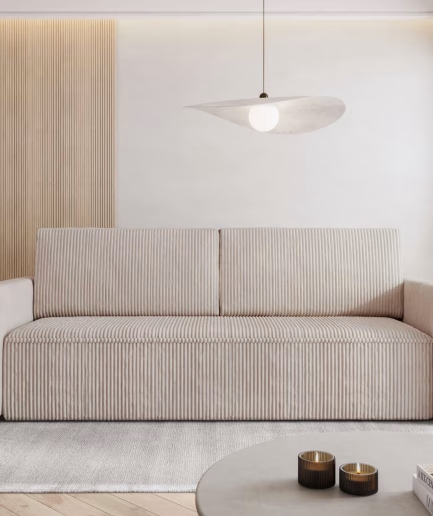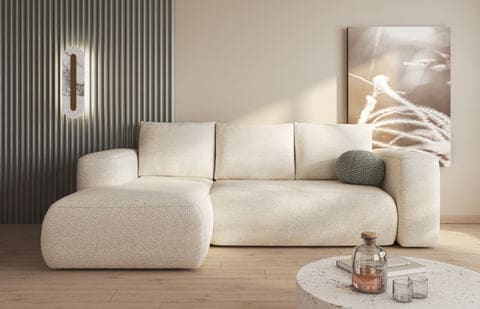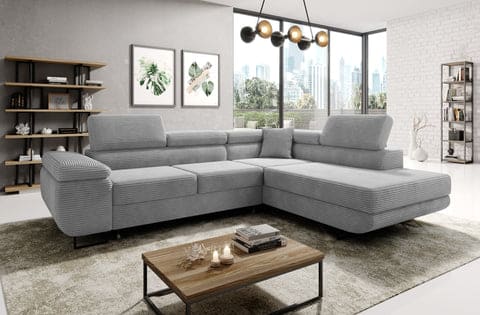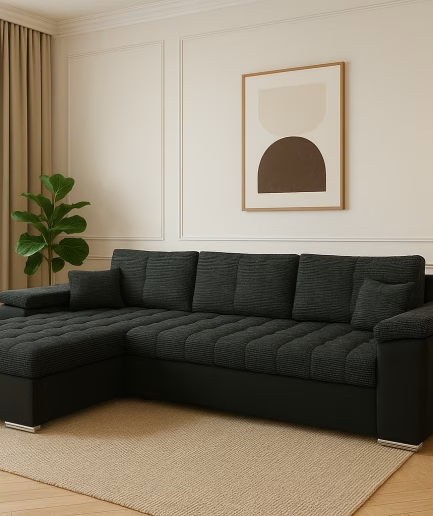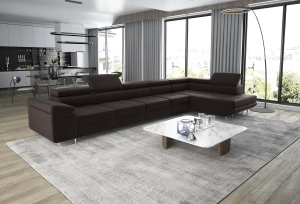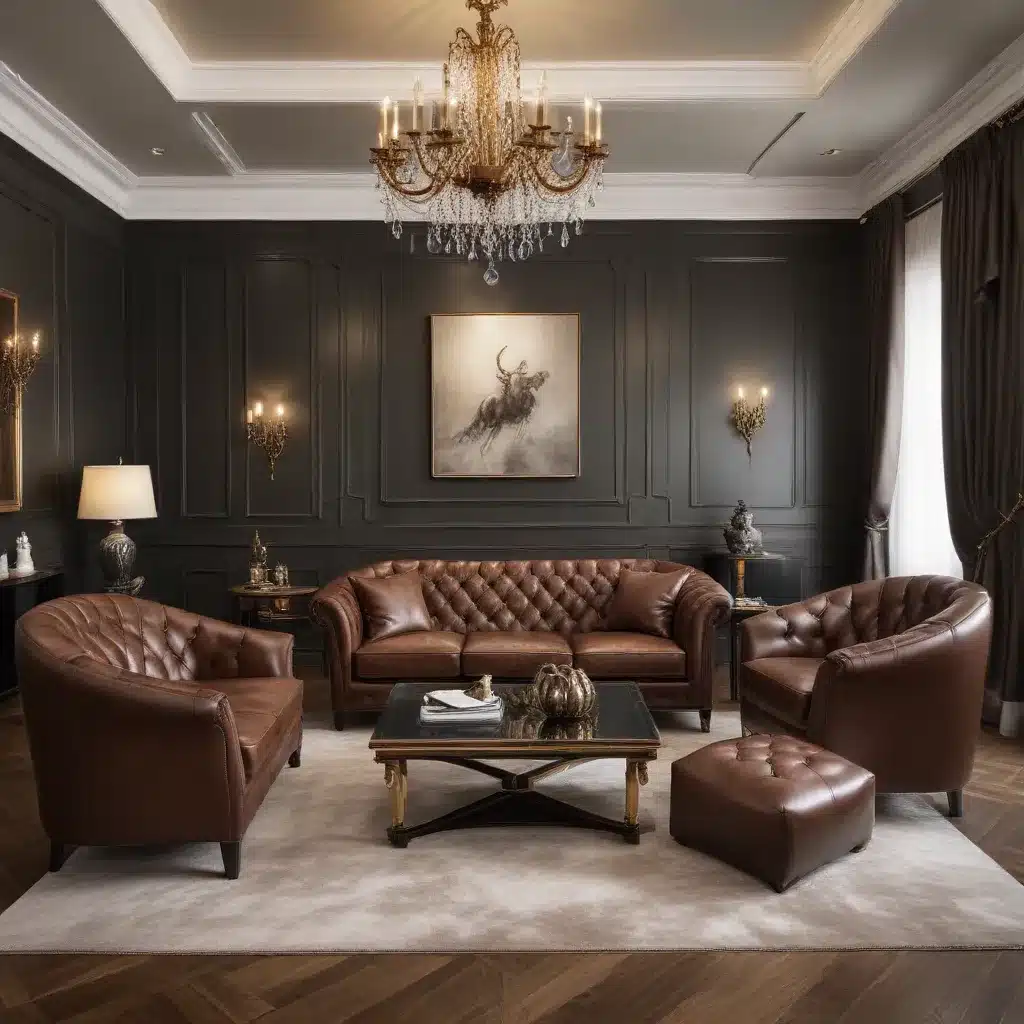
The Allure of Leather Sofas
As a furniture specialist with years of experience, I’ve seen countless living room setups, but there’s something truly special about a well-chosen leather sofa. It’s not just a piece of furniture; it’s a statement. When I walk into a room and see a beautifully crafted leather sofa, I can’t help but admire its presence.
Leather sofas have a unique ability to elevate the entire atmosphere of a living space. They bring a touch of sophistication that’s hard to match with other materials. I’ve often found myself running my hand along the smooth surface of a high-quality leather sofa, appreciating the coolness to the touch that gradually warms with contact – it’s an experience that fabric simply can’t replicate.
But it’s not just about the tactile sensation. The visual impact of a leather sofa is undeniable. Whether it’s a rich, deep brown that exudes warmth or a sleek black that screams modern chic, leather sofas have a way of commanding attention without overwhelming the room. I’ve seen how they can serve as the perfect centerpiece, tying together various design elements and creating a cohesive look.
Choosing the Right Leather Sofa
When it comes to selecting a leather sofa, there’s more to consider than you might think. I’ve guided countless clients through this process, and I always start by asking them to think about their lifestyle. Are you looking for something that can withstand the chaos of family life, or are you after a showpiece for a formal living room?
For those with busy households, I often recommend a more durable, pigmented leather. It’s easier to clean and can handle the occasional spill or scratch. On the other hand, if you’re after that butter-soft feel, aniline leather might be more your speed. It’s less resistant to stains, but the patina it develops over time is simply gorgeous.
Color is another crucial factor. While brown and black are classic choices, don’t be afraid to explore other options. I once had a client who was hesitant about a deep burgundy leather sofa I suggested, but it ended up being the perfect complement to their neutral-toned living room. It added just the right pop of color without being overwhelming.
The Practicality of Leather Upholstery
One of the questions I’m frequently asked is whether leather sofas are practical for everyday use. My answer is always a resounding yes – with a few caveats. Leather is incredibly durable and can last for decades if properly cared for. I’ve seen leather sofas that look better after years of use than fabric sofas do after just a few months.
Maintenance is key, of course. I always advise my clients to invest in a good leather conditioner and to use it regularly. It keeps the leather supple and prevents cracking. And cleaning? It’s often as simple as wiping down with a damp cloth. For tougher stains, there are specialized leather cleaners that work wonders.
Another practical aspect of leather sofas that I love is their hypoallergenic properties. For clients with allergies, I often recommend leather over fabric upholstery. It doesn’t harbor dust mites or pet dander the way fabric does, making it a healthier choice for many households.
Design Versatility of Leather Sofas
One misconception I often encounter is that leather sofas are limited in terms of design. Nothing could be further from the truth! I’ve seen leather sofas that fit perfectly into everything from ultra-modern minimalist spaces to cozy, traditional living rooms.
For a contemporary look, I might suggest a sleek, low-profile leather sofa with clean lines and metal legs. Pair it with some geometric throw pillows, and you’ve got a setup that would look right at home in a New York loft.
On the flip side, a tufted Chesterfield-style leather sofa can add a touch of old-world charm to a more traditional space. I once worked with a client who wanted to create a gentlemen’s club vibe in their study. A deep brown leather Chesterfield was the perfect choice, especially when paired with dark wood bookshelves and a vintage rug.
Leather Sofa Care and Maintenance
Taking care of a leather sofa isn’t difficult, but it does require some attention. I always tell my clients that a little regular maintenance goes a long way. Here’s a quick rundown of what I recommend:
- Regular dusting: Use a soft, dry cloth to remove dust weekly.
- Vacuuming: Use the soft brush attachment to get into crevices and seams.
- Conditioning: Apply a leather conditioner every 6-12 months to keep the leather supple.
- Spot cleaning: Address spills immediately with a clean, damp cloth.
- Avoid direct sunlight: Position your sofa away from windows to prevent fading and drying.
I once had a client who was hesitant about buying a white leather sofa because they were worried about maintenance. I assured them that with proper care, it could stay looking pristine for years. Sure enough, when I visited their home two years later, the sofa looked as good as new.
Leather Sofas in Different Living Spaces
The versatility of leather sofas never ceases to amaze me. I’ve incorporated them into all sorts of living spaces, each with its own unique challenges and requirements. Let me share a few examples that might inspire you:
Open-Plan Living Areas
In open-plan spaces, a leather sofa can serve as a beautiful anchor point. I once worked on a project where we used a large, L-shaped leather sectional to define the living area within a larger open-plan space. The rich, cognac-colored leather provided a warm contrast to the cool, industrial elements of the loft-style apartment.
Formal Living Rooms
For more formal settings, I often recommend a classic Chesterfield-style leather sofa. In one particularly memorable project, we paired a deep green leather Chesterfield with gold-framed artwork and crystal sconces. The result was a room that exuded sophistication and old-world charm.
Family Rooms
Leather sofas can be surprisingly family-friendly. I always recommend a more durable, treated leather for these high-traffic areas. In one family home, we chose a large, comfortable leather sectional in a warm caramel color. It was perfect for movie nights and could easily handle the occasional spilled juice or sticky fingers.
Home Offices
A leather sofa can add a touch of professionalism to a home office. For a client who wanted to create a space that could double as a meeting room, we selected a sleek, modern leather loveseat. It provided comfortable seating for clients while maintaining a businesslike atmosphere.
Mixing Leather Sofas with Other Furniture
One of the questions I’m often asked is how to incorporate a leather sofa into a room with existing furniture. The key, I find, is to create balance. Here are a few strategies I’ve used successfully:
-
Contrasting textures: If you have a leather sofa, consider adding fabric armchairs or a plush area rug to soften the overall look.
-
Color coordination: Use throw pillows or artwork that pick up colors from your leather sofa to tie the room together.
-
Mixing materials: Pair your leather sofa with furniture made from different materials like wood, metal, or glass to create visual interest.
-
Scale and proportion: Ensure that your leather sofa is appropriately sized for your space and other furniture pieces.
I remember working with a client who had inherited a beautiful antique leather sofa but was struggling to make it work in their modern apartment. We ended up pairing it with sleek, metal-framed side tables and a contemporary area rug. The juxtaposition of old and new created a unique, eclectic look that the client loved.
The Environmental Impact of Leather Sofas
As a furniture specialist, I’m often asked about the environmental impact of leather sofas. It’s a complex issue, and I always encourage my clients to consider both sides. On one hand, leather is a by-product of the meat industry, which means it’s using a material that might otherwise go to waste. On the other hand, the tanning process can be environmentally damaging if not done responsibly.
For eco-conscious clients, I often suggest looking for sofas made with vegetable-tanned leather. This process uses natural tannins from plant sources and is generally considered more environmentally friendly than chrome tanning. I’ve also seen an increase in the availability of leather sofas made with recycled leather, which can be a great option for those looking to reduce their environmental impact.
Another option I sometimes recommend is high-quality faux leather. While it’s not for everyone, modern faux leathers can be incredibly convincing and are often more environmentally friendly to produce. I’ve had clients who were pleasantly surprised by the look and feel of some of the newer faux leather options on the market.
Leather Sofas and Home Decor Trends
As someone who keeps a close eye on home decor trends, I’ve noticed that leather sofas have a unique ability to transcend passing fads. They have a timeless quality that allows them to adapt to changing styles around them. That said, I have observed some interesting trends in how leather sofas are being incorporated into contemporary interiors:
-
Bold colors: While traditional browns and blacks remain popular, I’m seeing more clients opting for leather sofas in unexpected hues like deep green, navy, or even bright red.
-
Mixed materials: Sofas that combine leather with other materials, such as wood or metal accents, are gaining popularity.
-
Modular designs: Flexible, modular leather sofas that can be rearranged to suit different needs are becoming increasingly popular, especially in smaller urban spaces.
-
Vintage and distressed looks: There’s a growing appreciation for leather sofas with a lived-in, vintage appearance. Some manufacturers are even artificially distressing new pieces to achieve this look.
-
Minimalist designs: In line with the overall trend towards minimalism, I’m seeing more sleek, streamlined leather sofas with less ornamentation.
I recently worked on a project where we incorporated a bright yellow leather sofa into a predominantly monochromatic room. It was a bold choice, but it perfectly exemplified the current trend of using a statement piece of furniture as a focal point in an otherwise understated space.
Investing in a Quality Leather Sofa
When it comes to leather sofas, I always advise my clients to think of it as an investment. A high-quality leather sofa can last for decades, often becoming more beautiful with age. But how do you ensure you’re getting a piece that will stand the test of time?
First and foremost, pay attention to the quality of the leather. Full-grain leather is the highest quality and most durable, followed by top-grain. These types of leather will develop a beautiful patina over time. Split leather or bonded leather, while less expensive, are not as durable and may not age as gracefully.
The frame is another crucial factor. Look for sofas with hardwood frames, preferably kiln-dried to prevent warping over time. The joints should be reinforced with corner blocks for added stability.
Suspension is also important. Eight-way hand-tied springs are considered the gold standard, but sinuous springs can also provide good support if well-constructed.
I once had a client who was hesitant about the higher price point of a high-quality leather sofa. I explained that when you amortize the cost over the lifespan of the piece, it often works out to be more economical than buying cheaper sofas that need to be replaced every few years. They took my advice, and years later, they still tell me it was one of the best furniture decisions they’ve ever made.
The Psychology of Leather Sofas
As a furniture specialist, I find the psychological impact of different furniture choices fascinating. Leather sofas, in particular, seem to evoke strong reactions in people. There’s a perceived luxury and status associated with leather furniture that can significantly influence how a space is perceived.
I’ve noticed that rooms with leather sofas often feel more formal and sophisticated. This can be great for creating an impressive first impression in a living room or a home office. However, it’s important to balance this formality with other elements to ensure the space still feels welcoming and comfortable.
Interestingly, the color of the leather can also have psychological effects. Dark leather tends to create a sense of depth and coziness, making it great for creating intimate spaces. Light-colored leather, on the other hand, can make a room feel more open and airy.
I once worked with a psychologist who was setting up her home office. We chose a warm, cognac-colored leather sofa to create an environment that felt both professional and comforting for her clients. The feedback she received was overwhelmingly positive, with many clients commenting on how the space made them feel at ease.
Leather Sofas in Commercial Spaces
While much of my work focuses on residential interiors, I’ve also had the opportunity to incorporate leather sofas into various commercial spaces. The durability and easy maintenance of leather make it an excellent choice for high-traffic areas.
In office reception areas, for example, a leather sofa can create a professional and welcoming first impression. I’ve found that opting for darker colors in these settings can help hide wear and tear, maintaining a polished look for longer.
For hotels and upscale restaurants, leather sofas can add a touch of luxury and sophistication. In one boutique hotel project, we used a combination of leather sofas and armchairs to create intimate seating areas in the lobby. The rich, buttery leather added warmth to the space and provided comfortable seating for guests.
In a high-end car showroom, we used sleek, modern leather sofas in the customer waiting area. The streamlined design and high-quality leather complemented the luxury vehicles on display, enhancing the overall customer experience.
The Future of Leather Sofas
As we look to the future, I see some exciting developments on the horizon for leather sofas. Sustainability is becoming an increasingly important consideration, and I anticipate we’ll see more eco-friendly leather options becoming available. This might include leathers tanned using more environmentally friendly processes or even lab-grown leather alternatives that mimic the look and feel of traditional leather.
Technology is also likely to play a role in the evolution of leather sofas. I wouldn’t be surprised to see the integration of smart features, such as built-in charging ports or even temperature-regulating technology.
In terms of design, I predict we’ll see a continued trend towards customization. More manufacturers are offering made-to-order options, allowing customers to choose not just the color and type of leather, but also the exact dimensions and configuration of their sofa.
As our homes continue to serve multiple functions, I also foresee an increase in multi-functional leather sofa designs. This might include sofas with built-in storage, adjustable backs for different seating positions, or modular designs that can be easily reconfigured.
Whatever the future holds, I’m confident that leather sofas will continue to be a staple in interior design. Their timeless appeal, durability, and ability to adapt to changing trends ensure their place in our homes for years to come.
For more information on selecting the perfect sofa for your space, whether leather or otherwise, be sure to check out our wide range of options at Sofa Spectacular. Our team is always ready to help you find the perfect piece to complement your home.




